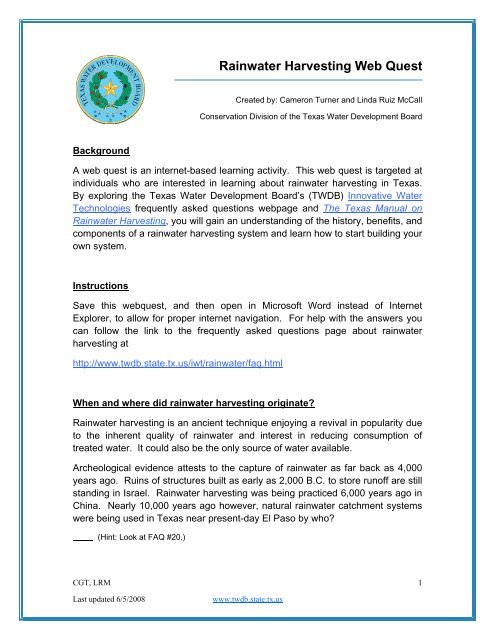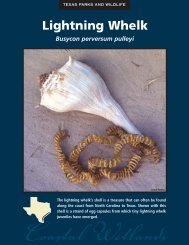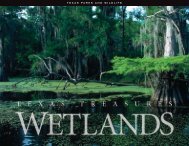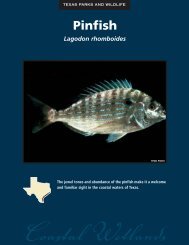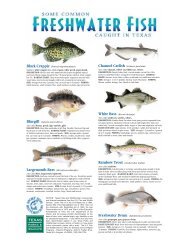Rainwater Harvesting Webquest - The State of Water
Rainwater Harvesting Webquest - The State of Water
Rainwater Harvesting Webquest - The State of Water
You also want an ePaper? Increase the reach of your titles
YUMPU automatically turns print PDFs into web optimized ePapers that Google loves.
<strong>Rainwater</strong> <strong>Harvesting</strong> Web Quest<br />
Created by: Cameron Turner and Linda Ruiz McCall<br />
Conservation Division <strong>of</strong> the Texas <strong>Water</strong> Development Board<br />
Background<br />
A web quest is an internet-based learning activity. This web quest is targeted at<br />
individuals who are interested in learning about rainwater harvesting in Texas.<br />
By exploring the Texas <strong>Water</strong> Development Board’s (TWDB) Innovative <strong>Water</strong><br />
Technologies frequently asked questions webpage and <strong>The</strong> Texas Manual on<br />
<strong>Rainwater</strong> <strong>Harvesting</strong>, you will gain an understanding <strong>of</strong> the history, benefits, and<br />
components <strong>of</strong> a rainwater harvesting system and learn how to start building your<br />
own system.<br />
Instructions<br />
Save this webquest, and then open in Micros<strong>of</strong>t Word instead <strong>of</strong> Internet<br />
Explorer, to allow for proper internet navigation. For help with the answers you<br />
can follow the link to the frequently asked questions page about rainwater<br />
harvesting at<br />
http://www.twdb.state.tx.us/iwt/rainwater/faq.html<br />
When and where did rainwater harvesting originate?<br />
<strong>Rainwater</strong> harvesting is an ancient technique enjoying a revival in popularity due<br />
to the inherent quality <strong>of</strong> rainwater and interest in reducing consumption <strong>of</strong><br />
treated water. It could also be the only source <strong>of</strong> water available.<br />
Archeological evidence attests to the capture <strong>of</strong> rainwater as far back as 4,000<br />
years ago. Ruins <strong>of</strong> structures built as early as 2,000 B.C. to store run<strong>of</strong>f are still<br />
standing in Israel. <strong>Rainwater</strong> harvesting was being practiced 6,000 years ago in<br />
China. Nearly 10,000 years ago however, natural rainwater catchment systems<br />
were being used in Texas near present-day El Paso by who?<br />
(Hint: Look at FAQ #20.)<br />
CGT, LRM 1<br />
Last updated 6/5/2008<br />
www.twdb.state.tx.us
What do you need?<br />
<strong>The</strong> basic components <strong>of</strong> a<br />
rainwater harvesting system are:<br />
1.<br />
2.<br />
3.<br />
4.<br />
5.<br />
6.<br />
(Hint: See chapter 2, page 5 <strong>of</strong> <strong>The</strong><br />
<strong>Rainwater</strong> <strong>Harvesting</strong> Manual.)<br />
What are the benefits?<br />
<strong>Rainwater</strong> is practically free, the only cost is to and .<br />
Because the end use is located close to the source, the need for costly<br />
systems can be eliminated.<br />
<strong>Rainwater</strong> is free <strong>of</strong> sodium. It is superior for landscape use, plants naturally<br />
thrive on it. <strong>Rainwater</strong> harvesting helps utilities peak demands during<br />
summer months. By harvesting rainwater, homeowners can reduce their .<br />
(Hint: See FAQ # 16.)<br />
<strong>The</strong>re is potential for Texas to use rainwater as an alternative supply source.<br />
Two billion gallons <strong>of</strong> water could be generated annually, if only 10 percent <strong>of</strong> the<br />
ro<strong>of</strong> area in the Dallas metroplex were used to harvest rainwater. If only 1<br />
percent <strong>of</strong> the total ro<strong>of</strong> area in the state were utilized to harvest rainwater,<br />
approximately, 11,650 acre-feet per year <strong>of</strong> additional water could be generated.<br />
An acre-foot is the amount <strong>of</strong> water it would take to cover an acre <strong>of</strong> land with<br />
one foot <strong>of</strong> water; it is equal to 325,851 gallons. (<strong>Rainwater</strong> <strong>Harvesting</strong> Potential and<br />
Guidelines for Texas, page 9.)<br />
CGT, LRM 2<br />
Last updated 6/5/2008<br />
www.twdb.state.tx.us
What does a typical system cost?<br />
Using existing gutters and downspouts, a simple rainwater harvesting system<br />
can be constructed by adding a rainbarrel for $50 or less. Many city water<br />
departments have these available at discounted rates. For a typical home, a<br />
complete rainwater harvesting system generally costs between $8,000 and<br />
$10,000. <strong>The</strong> is usually the biggest cost, but depends upon the size and<br />
construction material, <strong>of</strong>ten fiberglass or steel. Other components such as<br />
gutters, downspouts, and pumps add costs to the system. This is especially true<br />
if the intended use is to collect water for drinking; then cost for must be<br />
added to the total cost.<br />
Tax breaks and rebates are available in some areas <strong>of</strong> the state. Check with<br />
your local authorities, such as your county district, for potential county<br />
property tax exemptions. Thanks to Senate Bill 2, passed in 2001, rainwater<br />
harvesting systems are also exempt from . (Hint: FAQs # 7 & # 8.)<br />
How much could you collect?<br />
<strong>The</strong> amount <strong>of</strong> rainwater you can collect varies with the area <strong>of</strong> your collection<br />
surface and with the amount <strong>of</strong> rainfall you receive in your area. Rainfall totals<br />
vary across the <strong>State</strong> <strong>of</strong> Texas. <strong>The</strong> map below shows the annual average<br />
rainfall totals in inches. Red represents the least amount <strong>of</strong> annual rainfall<br />
averaging around 10 inches in El Paso; the dark blue represents 60 inches in the<br />
Beaumont area.<br />
With an assumed 85% system efficiency, the collectible volume <strong>of</strong> run<strong>of</strong>f is about<br />
0.62 gallons per square foot <strong>of</strong> ro<strong>of</strong> for every inch <strong>of</strong> rainfall. If you had a 2,000<br />
square foot home in Austin where annual rainfall is about 32 inches,<br />
approximately how many gallons could you collect?<br />
(Hint: Multiply collection rate, efficiency, square footage, and rainfall. See FAQ # 5)<br />
gallons<br />
By obtaining your average annual rainfall from the following map and using this<br />
same formula, you can estimate how much rainwater you could harvest from the<br />
actual square footage <strong>of</strong> your ro<strong>of</strong>.<br />
CGT, LRM 3<br />
Last updated 6/5/2008<br />
www.twdb.state.tx.us
Who is leading by example?<br />
In October 2007, TWDB announced the Texas Rain Catcher Award. <strong>The</strong> winner<br />
<strong>of</strong> the first quarterly award was Jacob White Construction Co. and architect Joe<br />
Webb in their project at the Medical Office Building in Webster, Texas. <strong>The</strong><br />
system collects water both from the ro<strong>of</strong> <strong>of</strong> the building and the parking lots. It<br />
contains underground storage to help with storm water retention and landscape<br />
CGT, LRM 4<br />
Last updated 6/5/2008<br />
www.twdb.state.tx.us
irrigation demands. <strong>The</strong> cisterns hold up to a three-month supply <strong>of</strong> water and<br />
supply the facility’s entire irrigation and gray water needs. (click here to link to<br />
full article)<br />
<strong>The</strong> winner <strong>of</strong> the second quarter (Spring 2008) was the Kight residence in<br />
Boerne, Texas. This is a good example <strong>of</strong> how an individual family addressed its<br />
water needs in an area with undesirable groundwater quality by harvesting<br />
rainwater. <strong>The</strong> Kights rely entirely on rainwater to meet all their needs: inside<br />
their home and outside. (click here to link to the full article)<br />
We look forward to seeing your application. Follow this link to find out more<br />
about this award. http://www.twdb.state.tx.us/iwt/rainwater/raincatcher.html<br />
Where can I get more information?<br />
<strong>The</strong> TWDB has a manual which presents the basics <strong>of</strong> residential or small-scale<br />
commercial rainwater harvesting systems design. This is available on-line and is<br />
intended to be the first step in considering your options for building your own<br />
rainwater harvesting system.<br />
What other resources are available?<br />
http://texaswater.tamu.edu/conservation.rainwater.html<br />
http://www.twdb.state.tx.us/iwt/rainwater/links.html<br />
http://rainwaterharvesting.tamu.edu/index.html<br />
http://www.ci.austin.tx.us/watercon/rbfaq.htm<br />
http://www.lakotawatercompany.com/<br />
http://www.bluescopewater.com.au/<br />
http://www.earthplatform.com/<br />
http://www.greenbuilder.com/<br />
http://www.watercache.com/<br />
http://www.harvesth2o.com/<br />
http://www.envireau.co.uk/<br />
http://www.arcsa.org/<br />
http://www.ukrha.org/<br />
CGT, LRM 5<br />
Last updated 6/5/2008<br />
www.twdb.state.tx.us
<strong>The</strong> Texas <strong>Water</strong> Development Board’s mission is to <strong>of</strong> provide leadership,<br />
planning, financial assistance, information and education for the conservation<br />
and responsible development <strong>of</strong> water for Texas.<br />
CGT, LRM 6<br />
Last updated 6/5/2008<br />
www.twdb.state.tx.us


